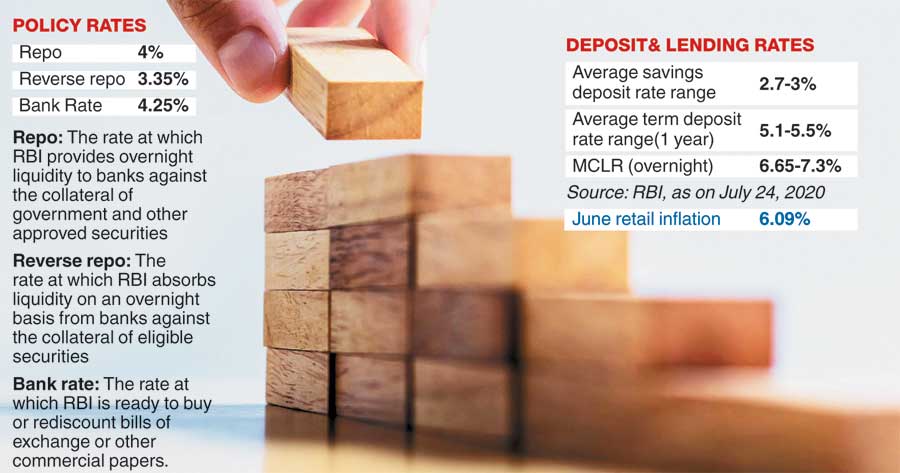Successive rate cuts by the banking regulator have rendered certain popular categories of term deposits quite meaningless, especially when viewed against advancing
inflation. Lower interest rates and inflationary trends are together resulting in negative yields for certain sections. In a situation like this, actively managed debt is a workable solution for investors who, however, must brace themselves for a patchy period marked by higher risk, particularly one that stems from weakening credit profiles of corporate borrowers.
In a backdrop marked by the alarming spread of Covid-19, various kinds of economic parameters have generally disappointed investors. Unsatisfactory credit offtake, supply bottlenecks and strained manufacturing activity have all combined to paralyse the influential sections of the economy.
Investment activity has turned a lot weak today. Businesses have faced disruption, profitability is greatly impacted, cash flows have suffered and doubts about corporate borrowers’ ability to satisfy lenders have emerged afresh. With a few green shoots on the horizon, the situation is not expected to turn for the better soon.
In the midst of all such distressing news is the latest spate of rate adjustments effected by various kinds of deposit mobilisers, including commercial banks and financial services outfits. The latter include housing finance companies that have been drawing considerable attention from the depositor community. The average deposit holder today has to strain his budget to derive value from his allocations, especially term deposits with banks. (See chart)

A distinct disincentive?
The ordinary individual’s life isn’t easy any more, considering the relatively disappointing yield that his hard-earned money is currently fetching. Remember, actual yields must be measured against a vital yardstick — consumer prices.
Consumer prices have increased, a situation resulting from what is commonly referred to as “supply side constraints”. One need not be a certified economist to understand the predicament. Simply put, shortages of all sorts (attribute it to the pandemic and the lockdown) have led to price hikes.
A saver who wishes to lock in his money for a year in, say, the country’s premier banking institution, will merely derive a bit more than 5 per cent today. That may not certainly be enough for a taxpayer, not if you consider the latest consumer price index.
This, therefore, serves as a clear disincentive for the common man. The disadvantages associated with the market — high volatility being one of them — are piled too high for him already. On his shoulders is the burden of income tax. Indeed, the inflation-and-tax concoction is a lethal mix for him.
Managed debt as alternative
Income yielding debt securities appear as a workable solution for the risk-taker who has the inclination to dabble in them, the current state of corporate credit ratings notwithstanding.
The popular approach centres around debt funds, which are a convenient way to hold a basket of select debt instruments.
Managed debt, aimed at adding stability to portfolios and at generating income, also bundles a major advantage — liquidity. In an open-ended structure, the investor can move out at the prevailing net asset value on any given business day.
In the present circumstances, many investors would like to confine themselves to low-risk debt funds, primarily those that offer short-term solutions.
The popularity of sundry liquid, money market, low duration and ultra-short term funds underlines the market’s preference for these categories.
But not without risk
Debt products are fraught with risks, one of which stems from interest rate movements. Another issue is the credit risk. Corporate bottomlines are strained at the moment. The ability of many borrowers to repay principal and pay interest is under considerable pressure. Before the lockdown, there were a few high-profile cases of default. The story that is likely to emerge after the lockdown will not be pretty — it could all end up in a bloodbath, it seems.
Hence, investors need to be aware of the following:
⚪ Follow a conservative strategy marked by safety (read: liquidity)
⚪ Choose funds that carry a significant number of well-rated securities in their portfolios. Triple-A rated corporate paper should be marked as a preference. Anything else, including AA-rated instruments, should be scrutinised carefully.
⚪ Be prepared to sacrifice some measure of yield. Not all yield-enhancing plans are worth the risk. Do not over-allocate to the so-called smart credit tactics followed by some ambitious fund managers.
⚪ If you are consistent enough and well aware of your investment objectives, you will be able to allocate your surplus in a diversified manner.
Stay committed to debt funds. If you are an orthodox player, place your trust in large banks, preferably ones with a lineage. Many PSU banks in India have been restructured and recapitalised in recent times. Keep one or two bank deposits at the core of your holdings. Make these the foundation of the fortress you aim to build for yourself. Debt funds, complete with active management of income-bearing securities, are your building blocks. Together, they will make a strong edifice.
The writer is director, Wishlist Capital Advisors











